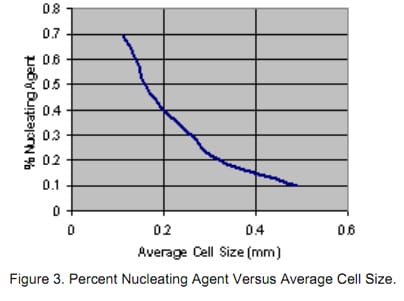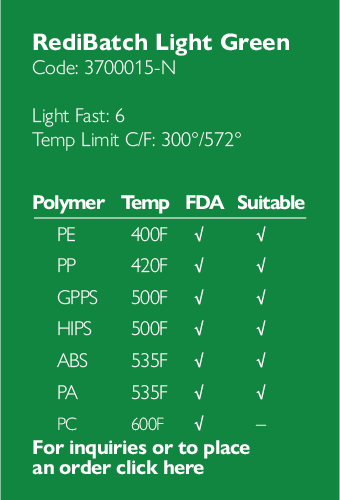The use of exothermic foaming agents to reduce the density of plastic parts and lower cost by using less resin is widely accepted. Exothermic foaming agents may also be used to eliminate splay marks in injection-molded parts and to improve transmission and electrical properties in wire and cable insulation. Did you know that even those who utilize physical blowing methods often use exothermic foam concentrates, such as azodicarbonamide, (ADC) as nucleating agents?
Nucleation taking place at an interface between the polymer and another phase is called heterogeneous nucleation. This may be contrasted to homogeneous nucleation, where thermodynamic instabilities are used to generate the nuclei of the gas cells. In heterogeneous nucleation, nucleating agents are critical for controlling the morphology of the cells being formed during the foaming process.  The presence of an efficient nucleating agent will facilitate the production of a larger number of smaller cells. That is, a higher cell density (cells/cm3), and thereby a lower density foamed product. Typically, particulate solids such as talc or silica are used as nucleating agents. The blowing gas is adsorbed on the surface of the particulate during phase separation. At this point, the accumulated gas is in an unstable intermediate state known as an “embryo.” If the embryo at the surface/resin interface exceeds the critical size to survive (then termed a nucleus), a cell will be formed. This results in a finer cell structure than simply blowing the part without any nucleating agent. However, these types of nucleating agents are not appropriate for producing very fine cell structure, and especially microcellular structure, by their size.
The presence of an efficient nucleating agent will facilitate the production of a larger number of smaller cells. That is, a higher cell density (cells/cm3), and thereby a lower density foamed product. Typically, particulate solids such as talc or silica are used as nucleating agents. The blowing gas is adsorbed on the surface of the particulate during phase separation. At this point, the accumulated gas is in an unstable intermediate state known as an “embryo.” If the embryo at the surface/resin interface exceeds the critical size to survive (then termed a nucleus), a cell will be formed. This results in a finer cell structure than simply blowing the part without any nucleating agent. However, these types of nucleating agents are not appropriate for producing very fine cell structure, and especially microcellular structure, by their size.
Another extremely effective method of nucleation exists using finely dispersed ADC (azodicarbonamide) in the melt. Being strongly exothermic, the ADC reacts to create “hot spots” in the melt, reducing the melt viscosity and surface tension locally. Figure 1 shows the density reduction of an injection-molded part using an endothermic blowing agent (Ampacet 703061-H), lab control, 703061-H with a talc nucleator, and with an ADC nucleator. In Figure 1 it can be seen that the blowing agent’s efficiency is greatly enhanced by the addition of a nucleating agent, whether it is talc or ADC. In this study, the ADC outperformed a talc of comparable particle size at the same concentration, in terms of density reduction.
This, in part, can be explained by a contribution from the gas generated by the ADC, but also by a significant contribution from the effectiveness of the ADC as a nucleator. Cross-sections of the injection-molded parts reveal a finer cell structure (smaller cells, higher density of cells) for the part foamed employing ADC as a nucleator, versus that of a talc nucleator.

Some possible explanations for the differences include: the number of embryos produced; the number of embryos that reach the critical size to become active nuclei; and the density distribution of active nuclei. These and others factors conceivably control the number of cells created and the rate at which they will coalesce, and thereby determine the cell structure of the foamed product. Whatever factors dominate, it is clear the ADC produces a finer cell structure, resulting in smaller and a greater number of cells
When using ADC as a nucleating agent, it is important to carefully control the processing temperatures so the ADC activates at the right time. Optimally, the ADC is activated immediately before foaming. Premature activation can result in a loss of effectiveness of the ADC nucleating agent. Fortunately, Ampacet offers a variety of ADCs that activate at various temperatures, so you can choose the one that best fits your current process.

The concentration of the ADC in the part determines the number of cells, and therefore the cell size. The relationship is demonstrated in Figure 3, where increasing nucleating agent concentration results in a decrease in average cell size. For nucleation purposes, a concentration of 0.1-0.7% ADC is needed; most typically about a 0.3% ADC concentration. Nucleation by ADC is a valuable method of generating a foamed plastic part or insulation with a fine cell structure. Ampacet offers ADC foam concentrates in a wide range of concentrations, activation temperatures, and a variety of resin carriers. Let us help you select the one that best fits your needs.
































